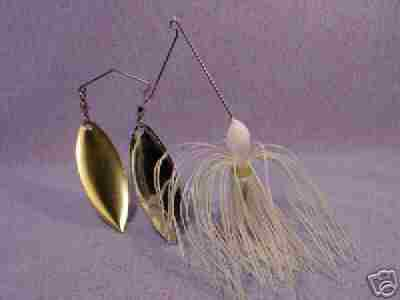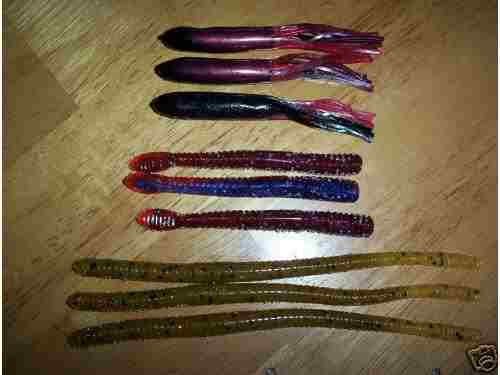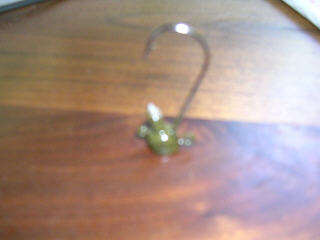Search
Latest Articles
BLIND FISHING SPAWNING BASS
by Bruce Middleton, April 03, 2005
Spring, the trees are turning green, new shoots are sprouting up everywhere and the winter doldrums are finally at an end. The sun seems to be out more, the air is still crisp in the morning but the afternoons are warm and comfortable. Each day gets longer and longer, the temperatures start to climb and the signs of spring are everywhere. The shallow ends of the lakes are starting to warm, bass and bait fish are moving out of the deep water and spawning beds are starting to appear everywhere you look. This is the best time of year to be a bass fisherman.
This is the time of year that every bass fisherman loves. Over wintered boats are taken out of storage and readied for another seasons work. Tackle boxes are inspected and new orders are placed to those lures that were lost or for the newest and greatest models on the market. New line is spooled on the reels and every thing is readied. Batteries are checked and new gas is mixed and the tanks are filled. Some even take the boat down to the nearest lake to "kick the tires and light the fires" just to feel the wind in their faces on the lake. A few crawfish traps are set out to see what color the crawfish are now and a constant eye is kept on the flats for the fist signs of the beds.
Spring is so popular because everybody knows exactly where the bass will be, in the shallows. And they will be there in vast numbers. This is the best time of the year to hook the biggest fish of the year and it’s the best time of year to hook the most bass in one outing. In short, it’s the glory days of spring bass fishing and everybody is drooling at the expectation of monster bass in 5 feet of water that they can see and can cast too. It just doesn’t get any better than that.
Pre-spawn bass are roaming the flats looking for food in preparation for the spawn and the spawner’s are already setting on their beds watching over their clutch of eggs and fry. Monster bass that you never see the rest of the year are in plain sight in three feet of water. You can count hundreds of bass in a small shallow protected cove. It’s an exciting time. But getting these bass to bite, well that’s a different story. The old adage still holds true, if the bass can see you he has lock jaw. Simply put, a bass is not likely to bite anything if he thinks he sees people associated with it. Their jaws lock up and they will just swim off if you pester them.
Sight fishing bass is a very tough thing to do even in the best of circumstances. It takes a lot of trial and error and a good coach to teach you the ins and outs of sight fishing and then it is almost a miracle if you get it right. First you have to be in an area that the bass haven’t been harassed to the point that a boat doesn’t spook them. This in itself is all but impossible on most lakes under 2,000 acres. There is just too much pressure on a small lake to even try to consider sight fishing for bass. Also you need a slightly dingy water condition. Most springtime lakes I fish are at there clearest in the spring. The idea is to get close enough to see the bass but far enough away that they don’t sense you as a threat. This means that you are at the extreme limits of your polarized vision, your wearing colors that match the sky so you’re harder to see and you keep your movements to a minimum so as not to draw attention to yourself. Location is key, you must never cast a shadow over a nest, you have to close enough to make a splashless entry and you have to be patient. Yes it can be done, but it takes a long, long time to learn how to be good at it.
A better way to fish bedding bass is to BLIND fish them. The best blind fishing is done in water too murky to see spawning bass in but it works just as well is sparkling clear water. In its simplest form, blind fishing spawning bass is fan casting the bedding flats using a short straight tailed worm rigged weedless and weightless. Now this may sound a bit hit-or-miss but it puts your bait right in the middle of the bedding flat. Bass beds, while scattered are still not all that much separated and they are usually far less that a single cast apart. Bass don’t like to be crowded.

It all starts with location. First the flat must be large enough to hold a substantial number of actively spawning bass. Next it must have a water depth range of 2 to 7 feet to meet the demands of different bass. Some spawn shallow and some spawn deep. Small pockets and bays off the main lake as well as creek inlets offer the most diversity to bass. Sandy or hard bottoms are the best type while weed-choked areas are the worst. A bass will spawn in 8 inches of water if that is the only place he can find that is suitable for building a nest site. This however doesn’t mean that grass won’t be present where the bass spawn, quite the opposite. Bass still prefer cover and it gives the fry someplace to move to when the males have moved off after his term of guard duty is over.
Besides the ever-popular plastic baits used for at this time of year, the ¼ ounce lipless Rat-L-Trap™ is an excellent lure to rip through the weeds in search of bass. Firstly it is an uncommon lure in shallow water and bass are always interested in something uncommon. But most importantly is how you fish it. You put the Rat-L-Trap just over the tops of the weeds and sometimes through them. When the lure hangs up in the grass you give the rod a good quick snap to break it free. This leaves a bit of slack in the line for a second until you catch up to it with the reel. This sudden movement of the lure out of the grass has cause more reaction strikes than just about any other lure. Be sure to use one with large bearings in the front and small BB’s in the rear for noise. This is the perfect combination of vibration and noise. Use chrome and chrome/blue lipless crank baits in clear water. In dingy to muddy water use orange, orange/red and fire-tiger ones. In the fall use crawfish red and orange colors and paint or replace the hooks with red ones.
3/8’s ounce spinner and buzz baits are also great spawning bed lures, although many anglers use the ½ ounce sizes. Chartreuse and white spinner baits and black or white buzz baits are the colors of choice with willow blades on the spinner baits and 3 blades on the buzz baits. Willow blades go through weeds better that Colorado blades and a three-blade buzz bait has all three blades stacked atop each other so at a short distance it looks like a one big blade. This enables you to keep the buzz bait on the surface with the slowest retrieve since it has the highest resistance. Remember too, that with a spinner and buzz bait to always use a trailer hook and to retrieve them as slowly as you can but still have them working correctly. Lastly, if a bass explodes all over a spinner of buzz bait and misses then won’t come back on the next cast. Instantly cast out our straight tailed worm. This will bag you 90% of the bass that won’t come back.

There are many presentations you can use to bag these bedding bass but one of the most deadly of the blind fishing baits is the use of a Buck-Eye Lure™ called a Spot Remover™ in conjunction with your favorite plastic bait. The Spot remover is a jig head. But unlike any other jig head the eye is 90 degrees offset and the front end is absolutely flat. It also has a ribbed spike on it to impale the plastic of your choice. In essences, this jig head is made to put the end of your plastic bait on the spike and then run the hook into the body of the plastic so it is weedless. The shape of the jig head has a flat front end so that it always falls on this flat spot and stands the plastic straight up in respect to the bottom. Like a floating plastic bait the tail is always sticking up so it is easily seen and easily bitten. It was originally intended for spotted and small mouth bass but when it comes to bedding large mouth bass it is just unstoppable. Bass just can’t stand it when something is standing up next to them in or near their bed. They go of their way to kill the bait. It is truly amazing the number of bass this simple jig head can catch with the right color worm, tube, crawfish or other plastic bait. Both sinking and floating plastics work with this jig head but smaller finesse type sinking worm models seem to cause more of a stir during spawn while floating, longer models in the summer and fall work best. Work the bait with patience and go slowly. It may take hours to cover even a small flat.

This is a light line presentation where fluorocarbon line is a must. Spawning bass are the spookiest bass in the world. They are in shallow water and exposed to predators from above as well as below. They also know about fishing pressure or at least the big ones do. They are cautious to the extreme. Don’t let a simple thing like too heavy a line or colored line keep you out of the game. This is also the time for finesse baits. Small offerings are more widely accepted than big ones.
When blind fishing, one thing you can do to improve your odds of finding bass in a hurry and casting to them directly, is to not look for bass but look for the beds themselves. A bass’s bed is a different color that the surrounding colors. More times than not it will be a lighter color because the darker silt has been removed, revealing the sandy bottom. This color change can be seen from a great distance, sometimes 3 to 4 times the distance that you can see a bass. With a bed in sight, you can cast to it and work the surrounding area, looking for other beds all the while. This is a huge advantage. Where you were trying to sight fish bass and trying to move to within 10 to 12 feet of them, you can now fish a bed from 35 to 60 feet away or more. Your chances of spooky a bass from this distance is minimal, but your chances of catching a bass at this distance just when up by a huge percentage.
Location, location, location, that is the key. The angle of the sun can affect how far you can see at any time of day. Shade from the shoreline can also affect how far you can see under water. From the boat, every angle you choose to look in has more or less distance you can see because of reflection, shade, glare and the height off the water your at. No need to tell you that polarized glasses are a must here.
With polarized sunglasses you want 95% polarized efficiency. Optical quality glass lenses are the best. Avoid plastic and polycarbonates lenses as they are a cheap substitute and are unlikely to achieve 95% polarization. All sunglasses have 100% UV protection so don’t let that sales pitch throw you off. 88% polarization is inferior. 95% is superior. As with most things you get what you pay for. Blue blockers and other gimmicks are just that. Go to a real Optometrist, even if you don’t need corrective lenses. Just tell him/her that you would like a pair of 95% polarized sunglasses with no correction in the glass lenses. How simple can that be? You try on some styles of frames. Make a choice and you’re out of there. Good polarized sunglasses are a must have for sight fishing bass. They cut water surface glare to zero so you can see underwater better. This makes spotting fish much easier. Yes you can order polarized sunglasses from any catalog but optical quality glass that has been hardened will outlast these 5 to 1 and they will cost you about ½ of what an expensive pair of plastic name brand ones will. Go with the glass ones for one other reason if nothing else, if they break or something part breaks on them you can take them in to have them repaired, usually free for the first year and at a small fee there after. This beats just throwing them away and buying a new pair.
To avoid alerting the bass to your presents, use the trolling motor as little as possible and on low speed when you do. The idea is to stay 35 to 60 feet away from the bass. Also you will notice that at this distance the bass will have a tendency to inhale the bait. When sight fishing, your right up on top of the bass and they seem to peck at but from a distance they slurp it in greedily and swim back to their nest leaving you plenty of time to set the hook. This is just one more advantage of blind fishing spawning bass.
In really clear water the bass may be so harassed that the mere sight of a boat sends them fleeing for cover or they will sit still and absolutely not strike anything. For these bass you have to back way off and make exceptionally long casts to work the area over well. This ploy will pay dividends if you wait for the fish to recover for a few minutes before casting and you use long casts that don’t splash much. Tiki sticks are a good choice for this type of fishing. The weight of the plastic is heavy enough to cast a great ways and it doesn’t make a huge entry splash that anything with a weight would make.
Knowing your strengths and weaknesses is important in bass fishing. Always fish your strengths and try to improve your weaknesses. Experiment all the time, learn all the time and always be patient.
Bruce Middleton
bmiddleeton_9900@msn.com


